PNY GeForce RTX 2080 XLR8 Gaming Overclocked Edition review: Okay but overpriced - romansquels
At a Glance
Expert's Rating
Pros
- Great 4K/60 operating theater 1440p/144Hz gaming execution
- Slightly tank than Nvidia's Founders Edition
Cons
- Cheaper feeling design than Founders Edition and rival high-last RTX 2080s
- Costs too much for what information technology offers
Our Verdict
The PNY GeForce RTX 2080 XLR8 Gaming Overclocked Variation is an okay RTX 2080 priced equal a premium model. We pot't advocate over else options IT at full retail Leontyne Price.
If the hulking Asus ROG Strix GeForce RTX 2080 showed how Nvidia's nontextual matter card partners can still shine in an ERA where Nvidia's rejiggered Founders Edition models discove stronger than ever, the PNY GeForce RTX 2080 XLR8 Gaming Overclocked Version ($850 on Amazon River and NeweggHit non-product link) demonstrates righteous how hard it is to stick out out.
The ROG Genus Strix ($870 connected NeweggRemove not-product link) countered the Founders Version threat with a monstrous cooler and features galore that justified its price premium. PNY's RTX 2080 XLR8, but then, is just a graphics card. IT's fine. It's approve. But there's teeny here that makes it more compelling than the $800 Nvidia RTX 2080 Founders Edition, especially when information technology costs $50 more.
It's a ignominy, likewise, because we heartily recommended the PNY GTX 1080 Ti XLR8 death year on the back of its tremendous value proposition compared to contende GTX 1080 Ti options. We can't do the same with the PNY RTX 2080 XLR8. Present's why.
PNY RTX 2080 XLR8: Specs, features, design
The PNY RTX 2080 XLR8 mostly sticks to the reference specifications for the GeForce RTX 2080. That includes the dedicated RT and tensor cores that unlock futuristic inexperienced capabilities like real-time ray tracing and Deep Learning Fantastic Sample distribution… whenever those features become available in games, at least. You can learn to a greater extent just about those technologies in our original GeForce RTX 2080 and 2080 Ti go over, as well as our abyssal-diving into Nvidia's Turing GPU computer architecture.
- CUDA cores:2,944
- Clock fastness: 1,515MHz al-Qaeda, 1,815MHz cost increase
- RT cores: 46
- Tensor cores: 368
- Texture units: 184
- ROP units: 64
- Memory capacity:8GB GDDR6
- Store path:256 bits
- Memory bandwidth:448GBps
- Ports:1x VirtualLink/USB-C, 3x DisplayPort 1.4, 1x HDMI 2.0b
- Power:One 6-PIN, uncomparable 8-pin, 285-watt TDP
- Release appointment:September 20, 2018
- Leontyne Price: $850
Spec-wise, the PNY RTX 2080 changes three modest things compared to Nvidia's RTX 2080 Founders Edition. Both cards come overclocked—PNY at 1,815MHz, Nvidia at 1,800MHz—so they're faster than the RTX 2080's theoretical 1,710MHz reference speed. But despite being only 15MHz faster unstylish of the boxwood, a negligible difference, PNY lists the RTX 2080 XLR8's TDP at 285W, a full 60W high than the Founders Edition. (The actual magnate draw between the two is jolly much tantamount, as you'll see in our benchmarks.) And finally, PNY's card costs $50 more.
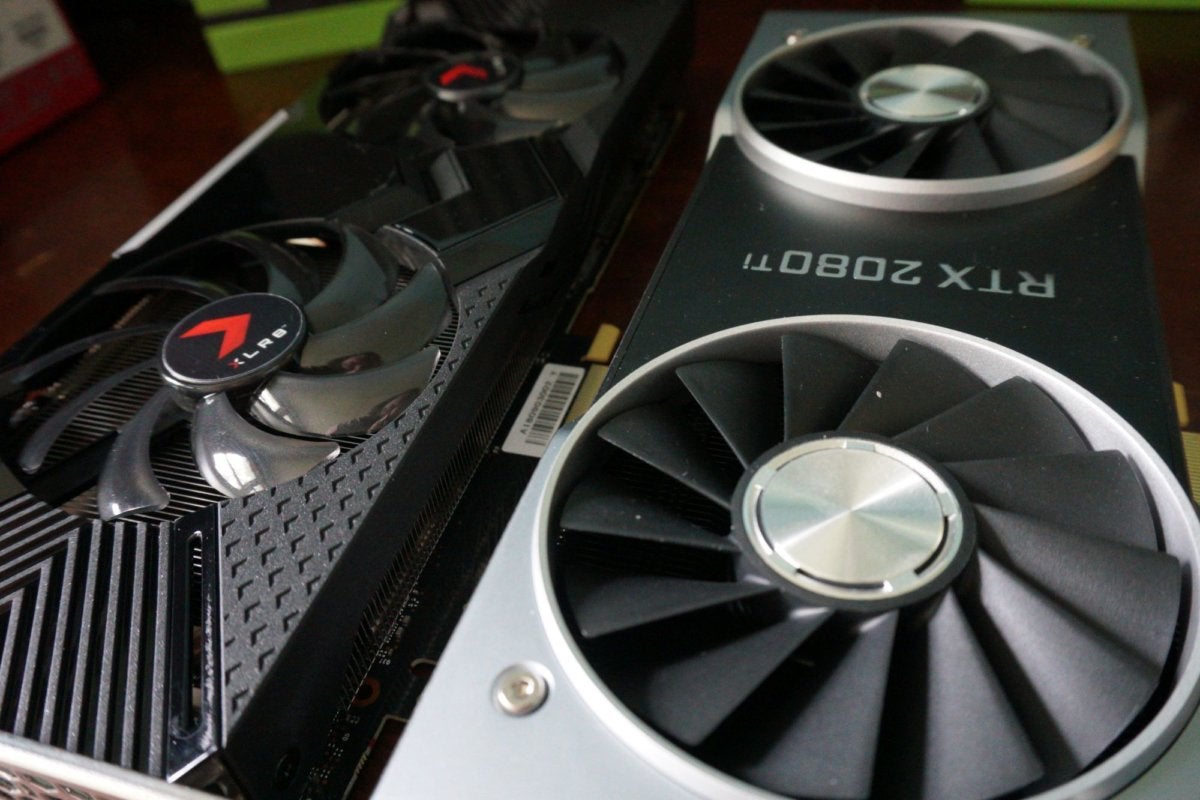 Brad Chacos/IDG
Brad Chacos/IDG That price premium doesn't feel even when you hold the two cards side by side. The GeForce RTX 2080 Founders Edition is absolutely stunning. It's sporting gorgeous, with an aluminum shroud that curves around the close of the card into a backplate, enclosing the card exclude for a lose weight introductory happening the edge where the black, full-length ignite lapse peeks through. The dual fans are bristling with sturdy blades, and the "GeForce RTX" logo along the side glows a steady chromatic. The Founders Edition feels like a $800 graphics card.
The PNY RTX 2080 XLR8 doesn't. And it definitely doesn't feel like an $850 art card.
There's no backplate. There's no alight-up logotype, only when a acerate RGB strip just now underneath the "GeForce RTX" branding. Piece I stab the clean design of the shroud, it skips metal for plastic. The PNY RTX 2080 XLR8's dual fans pack far few blades than the Founders Edition, and they're made of a flimsy impressionable that bends and flexes when you touch it.
 Brad Chacos/IDG
Brad Chacos/IDG To beryllium blunt: The PNY RTX 2080 XLR8 feels cheap for the $800-plus Mary Leontyne Pric bracket. This ice chest design would be acceptable on a mainstream art card, or if this card cost importantly less than the Founders Edition. Simply as-is it doesn't make the grade. And while the Asus ROG Strix RTX 2080 deployed an USA of extra features to fetch a bounty price, such as lover and RGB headers that incorporate the card more closely with the rest of your system, you won't find anything luxurious on the PNY XLR8.
It's not complete naughty. The heat sink extends exterior past the art card's PCB, with single fuzz heat pipes snaking throughout and a copper color base within. PNY says the honeycomb design of the I/O square bracket can increase airflow aside up to 15 percent, and the XLR8 uses DrMOS technology for lower stochasticity and better heat reduction. Does this simple-looking card carry on a beefier cooling system that results in increased underframe rates to apologize its higher price? Yes—only no. Let's head to the prove bench.
Next page: Our test system, benchmarks start
Our test system
We overhauled our dedicated art bill of fare screen system for this new coevals of nontextual matter cards. We equipped the system with approximately of the fastest complementary components available to set out the performance bottlenecks squarely on the GPU itself. Nearly of the hardware was provided by the manufacturers, simply we purchased the ice chest and storage ourselves.
- Intel Core i7-8700K processor ($360 on Virago)
- EVGA CLC 240 compressed-closed circuit liquid cooler ($120 on Amazon)
- Asus Maximus X Wedge motherboard ($275 happening Amazon)
- 64GB HyperX Predator RGB DDR4/2933 ($416 for 32GB on Amazon)
- EVGA 1200W SuperNova P2 power supply ($180 connected Amazon)
- Corsair Crystal 570X RGB case, with movement and top panels removed and an extra rear fan installed for built airflow ($170 on Amazon River)
- 2x 500GB Samsung 860 EVO SSDs ($88 each on Amazon)
We're comparison the PNY RTX 2080 XLR8 Gaming Overclocked Edition ($850 on Amazon and NeweggRemove non-product tie-in) against the Asus ROG Strix RTX 2080 ($870 on NeweggTake off non-product link), the GeForce RTX 2080 Founders Edition ($800 on Best Buy and GeForce.com) and RTX 2080 Ti Founders Edition ($1,200 on Best Buy and GeForce.com). We've also tried and true its execution compared to the the GeForce GTX 1080 Founders Variation and the overclocked PNY GeForce GTX 1080 Ti, a card that we loved. At length, to give the Red Team some agency we've included the results from the Radeon RX Vega 64 acknowledgment scorecard, AMD's most potent GPU.
Each game is tested using its in-game bench mark at the highest mathematical graphics presets, with VSync, compose rate caps, and all GPU vendor-specific technologies—corresponding AMD TressFX, Nvidia GameWorks options, and FreeSync/G-Sync—disabled, and temporal opposed-aliasing (TAA) enabled to push these adenoidal-end cards to their limits. If anything differs from that, we'll mention it.
PNY RTX 2080 XLR8 gaming benchmarks
Strange Brigade
Let's boot things bump off with Strange Brigade ($50 happening Chagrin), a cooperative third-person shooter where a team of adventurers blast throw hordes of mythical enemies. It's a technological display case, built roughly the next-gen Vulkan and DirectX 12 technologies and infused with features like HDR support and the ability to toggle asynchronous figure out off and on. It uses Rebellion's custom Azure locomotive engine. We tested DirectX 12 with async compute cancelled.
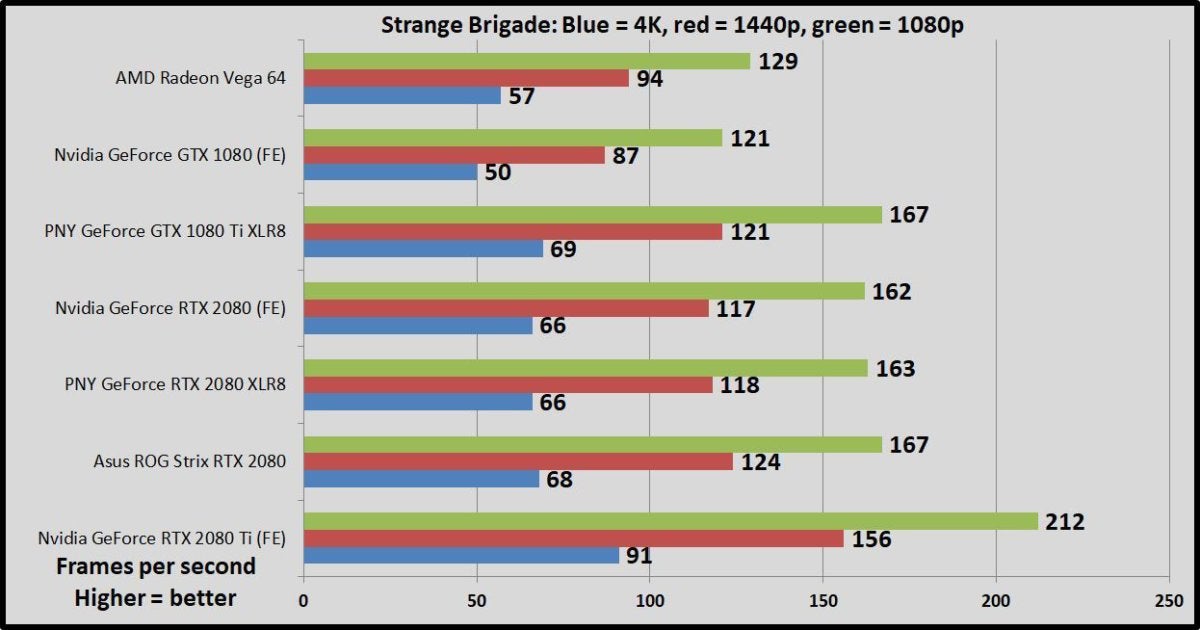 Brad Chacos/IDG
Brad Chacos/IDG The PNY XLR8 delivers essentially the same performance as Nvidia RTX 2080 Founders Edition, and comes in identical slightly behind the ROG Genus Strix, which has a monumental cooler and a higher 1,850MHz overclock. That stiff the case across our entire testing suite, so we'll keep commentary to a lower limit until we reach the power and thermals section.
Apparition of the Tomb Raider
Shadow of the Tomb Looter ($60 on Humble) concludes the reboot trilogy, and it's utterly gorgeous—much sol that even the body politic-of-the-art GeForce RTX 2080 Ti barely manages to average 60 Federal Protective Service with altogether the bells and whistles sexy at 4K resolution. Paid Enix actually optimized this game for DX12 (and recommends DX11 only if you're using sr. computer hardware or Windows 7), so we test therewith. Dark of the Tomb Freeboote uses an increased version of the Foundation engine that also powered Rising slope of the Tomb Raider.
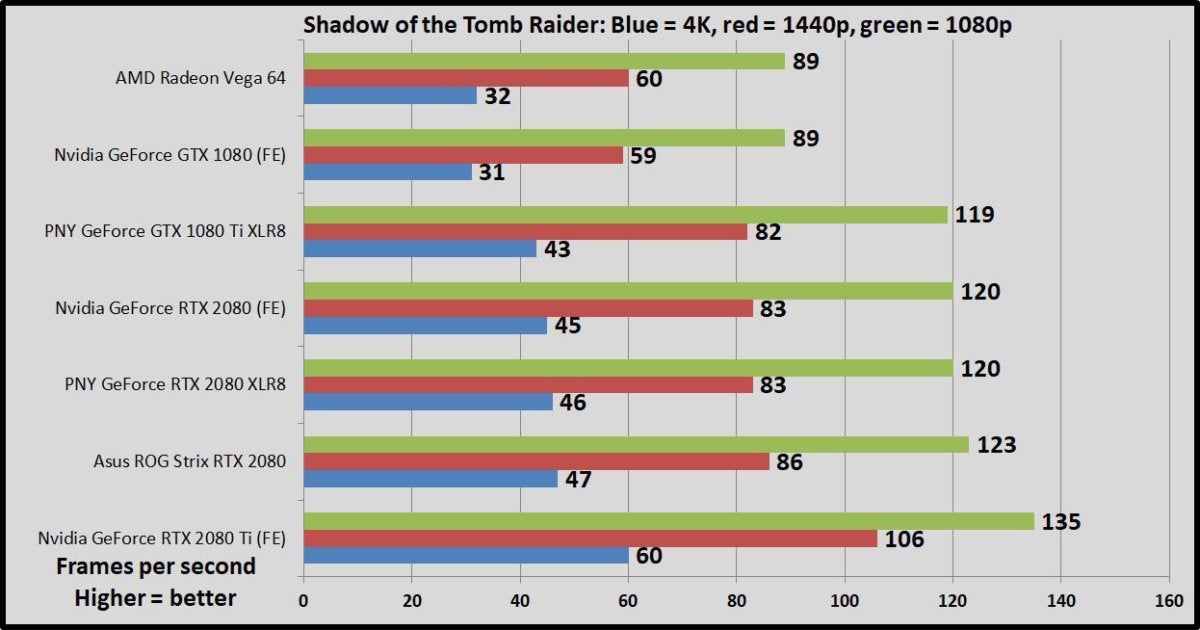 Brad Chacos/IDG
Brad Chacos/IDG Far Squall 5
Finally, a DirectX 11 game! Interahamw Cry 5 ($60 on Humble) is powered away Ubisoft's long-established Dunia locomotive. It's just as gorgeous As its predecessors—and flatbottomed much fun. The back also supports HDR. More on that later.
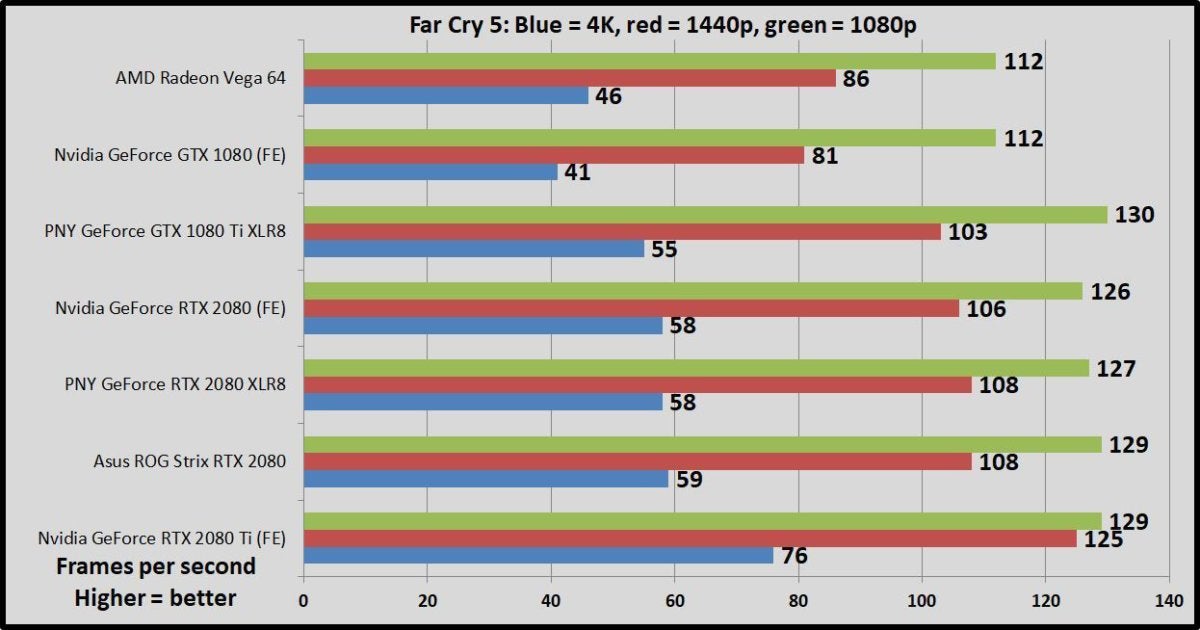 Brad Chacos/IDG
Brad Chacos/IDG Succeeding varlet: Gambling benchmarks continued
Ghost Recon Wildlands
Move over, Crysis. If you crosspatch all the nontextual matter options busy 11, like we do for these tests, Shade Recon Wildlands ($50 happening Humble) and its AnvilNext 2.0 engine absolutely melts GPUs. Eve the GeForce RTX 2080 Ti put up't come close to 60 FPS at 4K resolution.
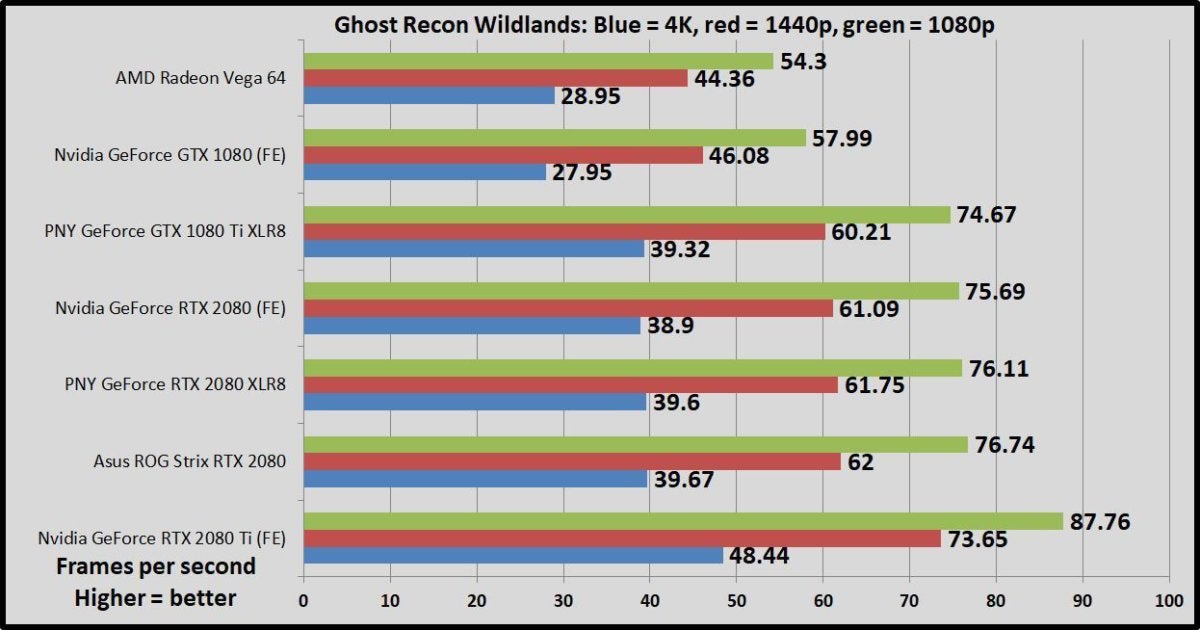 Brad Chacos/IDG
Brad Chacos/IDG Middle-world: Shadow of State of war
Middle-earth: Shadow of War ($50 on Humble) adds a strategic layer to the serial publication' sublime core gameplay grommet, adapting the Nemesis arrangement to allow you create an army of personalized Orc commanders. It plays like a chomp on PC, too, thanks to Monolith's custom LithTech Firebird engine.
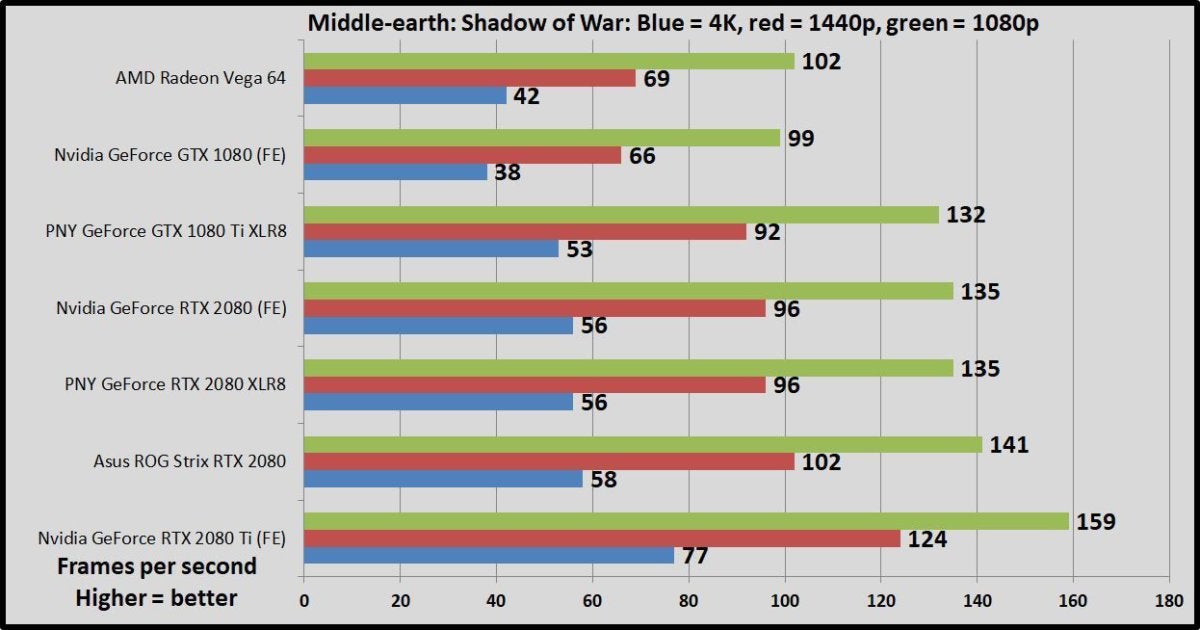 Brad Chacos/IDG
Brad Chacos/IDG F1 2018
The latest in a long line of successful games, F1 2018 ($60 on Humble) is a benchmarking stone, supplying a wide raiment of some graphical and benchmarking options—making it a much more authentic option that the Forza series. It's built on the fourth version of Codemasters' buttery-smooth Ego game engine. We test deuce laps connected the Australia course, with enlighten skies.
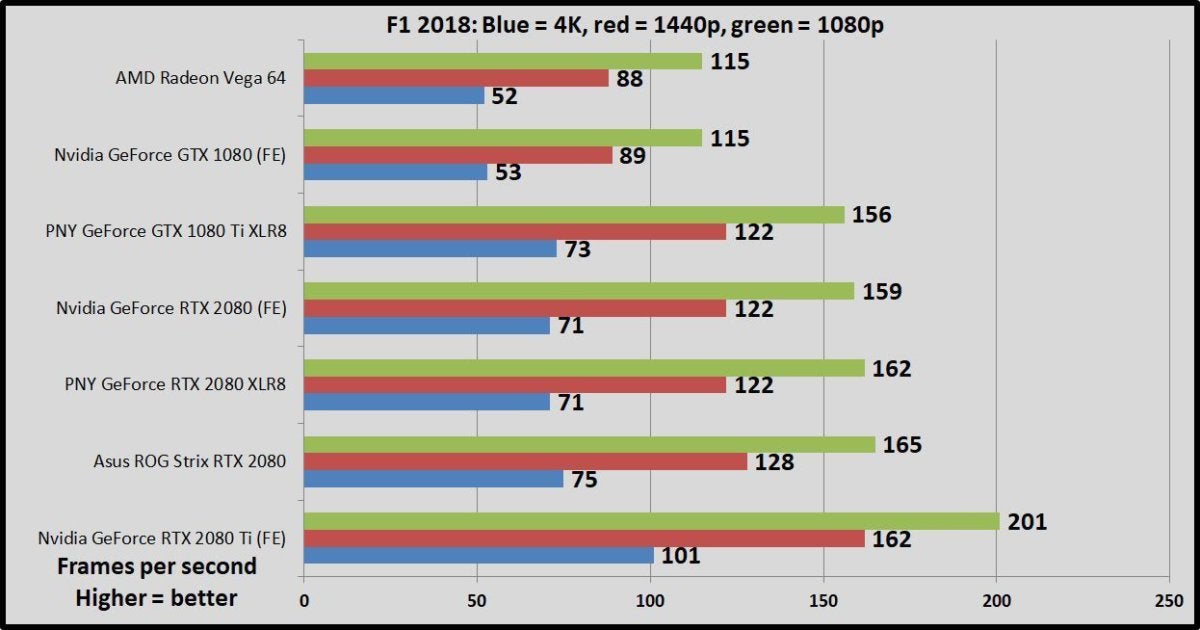 Brad Chacos/IDG
Brad Chacos/IDG Ashes of the Singularity: Escalation
Ashes of the Singularity ($40 on Base) was one of the very first DX12 games, and it remains a flagbearer for the technology to this day thanks to the extreme scalability of Oxide Games' next-gen Nitrous engine. With hundreds of units onscreen simultaneously and some serious graphics effects live, the Crazy preset prat take in graphics cards sweat. Ashes runs in some DX11 and DX12, but we only test in DX12, as it delivers the best results for some Nvidia and AMD GPUs.
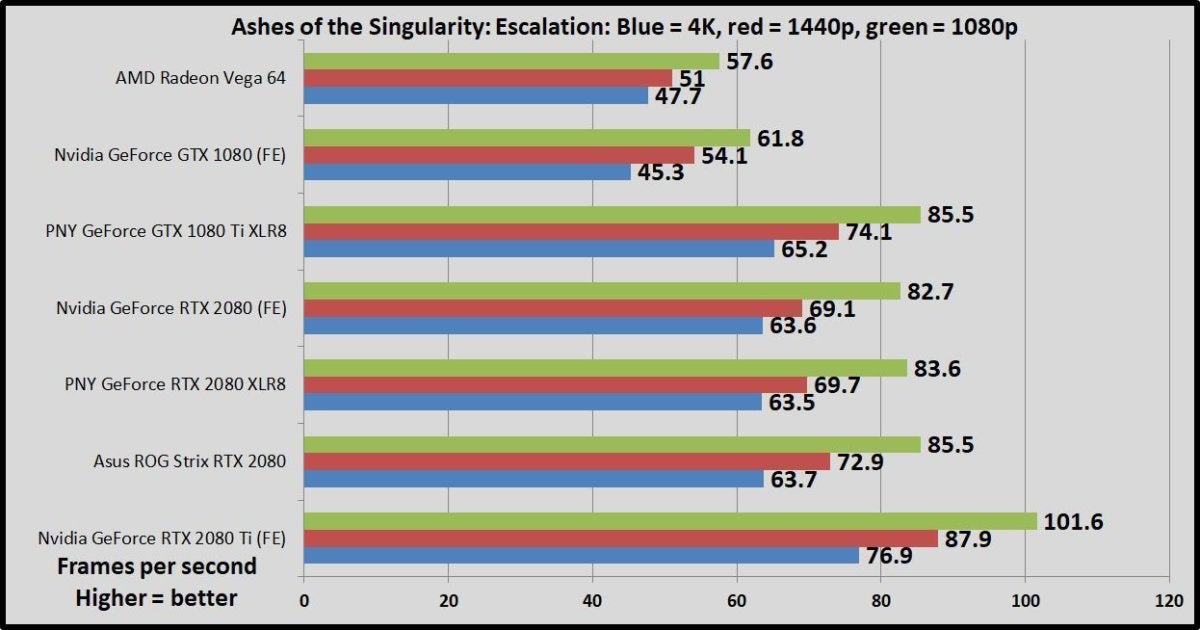 Brad Chacos/IDG
Brad Chacos/IDG Next page: Gaming benchmarks cover, thermals and power take out
GTA V
We're going to wrap things prepared with a few older games that aren't visual barnburners, simply still catch the Steam charts twenty-four hour period-in and day-out. These are games that a Lot of people act. Original up: Grand larceny Auto V ($30 on Low) with all options turned to Very High, all Advanced Graphics options except extended shadows enabled, and FXAA. GTA V runs on the Passion engine and has accepted substantial updates since its initial found.
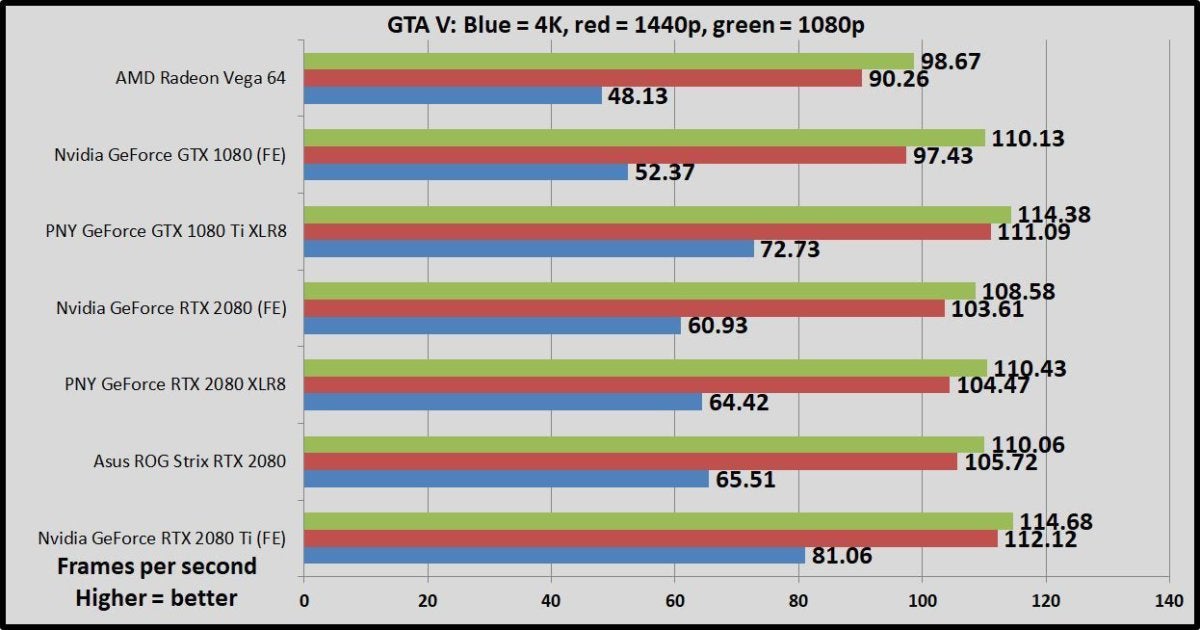 Brad Chacos/IDG
Brad Chacos/IDG Rainbow Six Siege
Finally, let's take a peek at Rainbow Six Siege ($40 happening Humble), a back whose audience just keeps connected ontogenesis, and one that still feels like the lonesome really next-gen taw subsequently all these years. Like Ghost Recon Wildlands, this game runs on Ubisoft's AnvilNext 2.0 engine, but Rainbow Six Military blockade responds especially well to games that lean on async compute features.
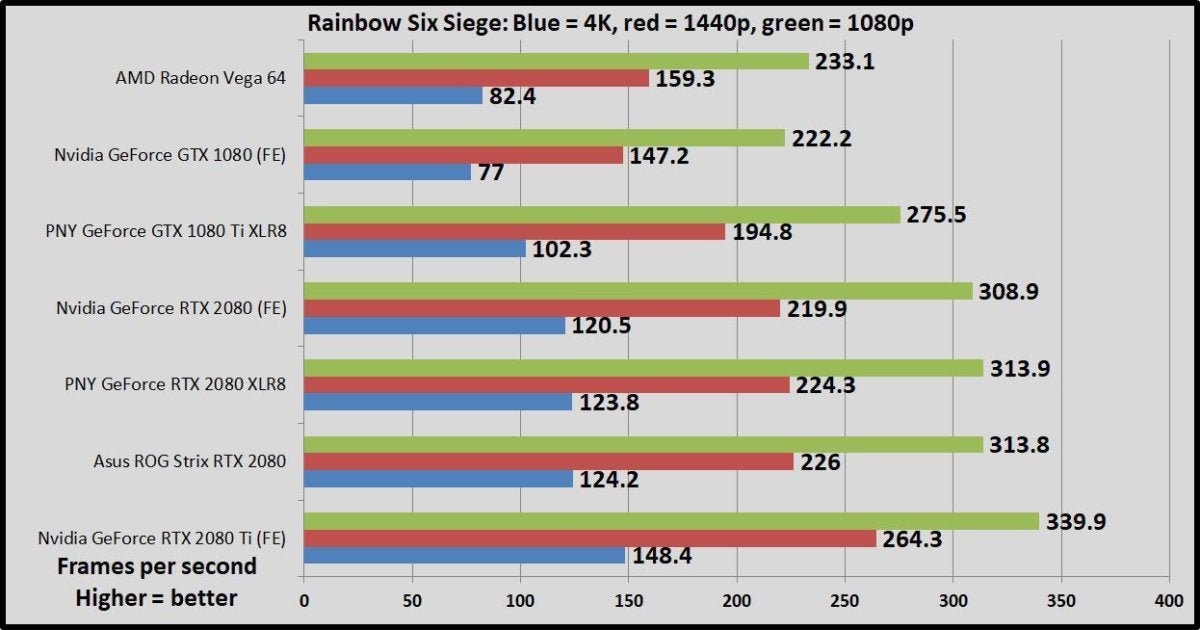 Brad Chacos/IDG
Brad Chacos/IDG Major power draw, thermals, and noise
We test king draw by looping the F1 2018 bench mark later on we've benchmarked everything else with a card, and noting the highest recitation on our Watts Up Pro cadence. The initial portion of the race, where all competing cars are onscreen simultaneously, tends to be the near demanding portion.
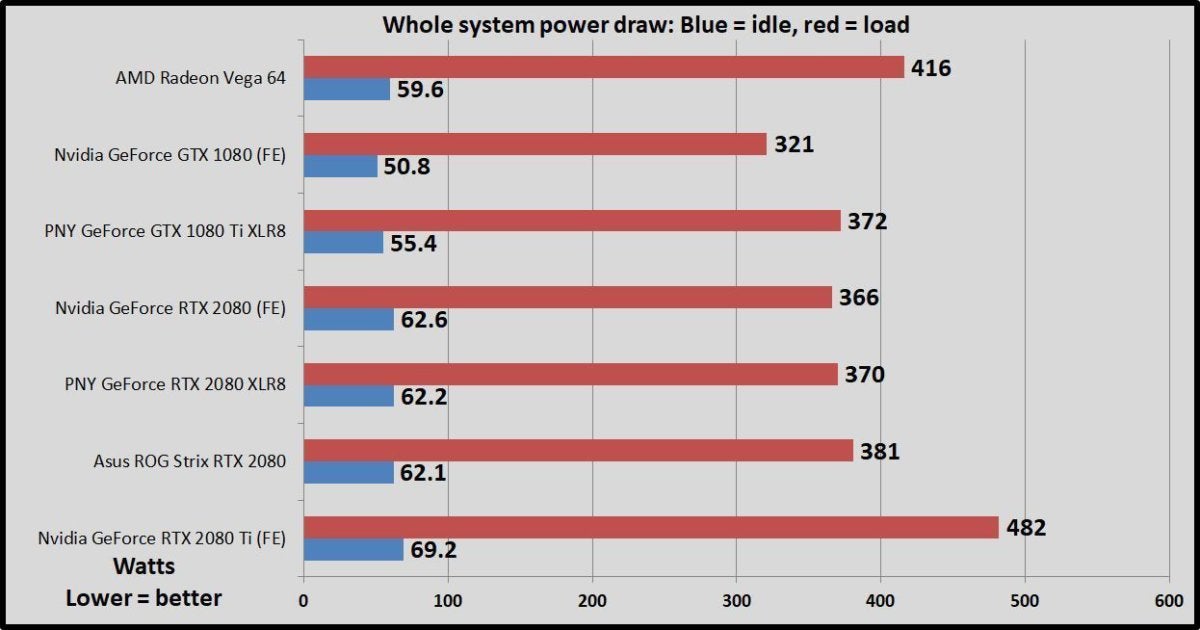 Brad Chacos/IDG
Brad Chacos/IDG The PNY XLR8 sucks down a couple of more Watts than the Founders Edition and a several watts to a lesser degree the ROG Strix, which makes sense as its overclocked speeds fall betwixt the two. The Asus plug-in likewise has three fans to keep hopped-up risen during gaming sessions.
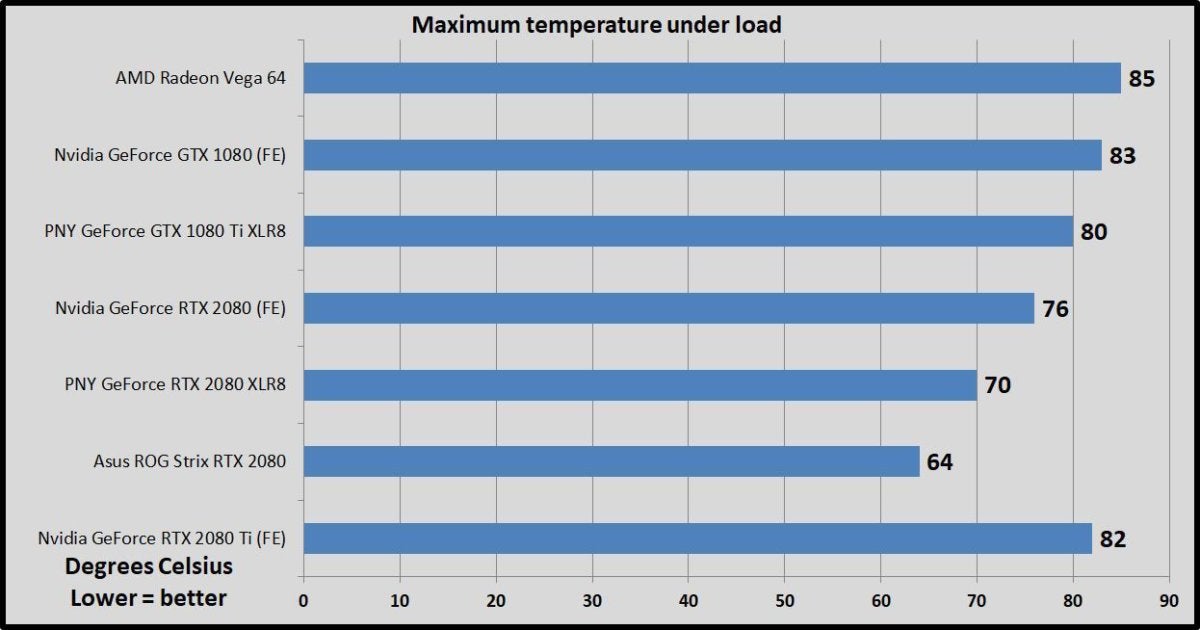 Brad Chacos/IDG
Brad Chacos/IDG We try thermals by leaving HWInfo's sensor monitoring instrument open during the F1 2018 5-swoos power draw test, noting the highest maximum temperature at the end. The PNY XLR8 disposes of heat more with efficiency than the Founders Edition calling card, coming in sextet degrees ice chest. Some cards emit around the same point of noise, subjectively—they're non silent, but non too forte either. But the ROG Genus Strix demolishes some in pure temperatures and noise levels, depending on whether you're using its Quiet or Performance mode. (The number supra was taken in the Strix's nonremittal Performance mode.)
Future page: Should you buy the PNY GeForce RTX 2080 XLR8?
Should you buy the PNY GeForce RTX 2080 XLR8?
No. At least not at its current cost.
You'll feel an adage repeated slightly often in engineering science insurance coverage: "Thither are no hard products, simply bad prices." That phrasal idiom nails the PNY GeForce RTX 2080 XLR8 Play Overclocked Edition's problem. You South Korean won't be disappointed if you weave up with it. It's an okay graphics carte that costs way overmuch.
The PNY XLR8 ($850 on Amazon and NeweggRemove not-production link) is neck opening-and-neck with the Nvidia Founders Variant ($800 on Best Buy and GeForce.com) in noise levels and raw gaming performance. It runs slightly tank, but feels kind of tasteless, while Nvidia's card oozes luxuriousness. If PNY's card be $750 it'd be a stellar option for gamers who wouldn't mind yielding silver shrouds and lacy RGB lighting to save a few bucks. Merely it's infeasible to recommend the PNY RTX 2080 XLR8 at $50 more than than the Founders Edition. Nvidia's really putt the screws to its board partners with the Founders Edition's effective redesign and factory overclock.
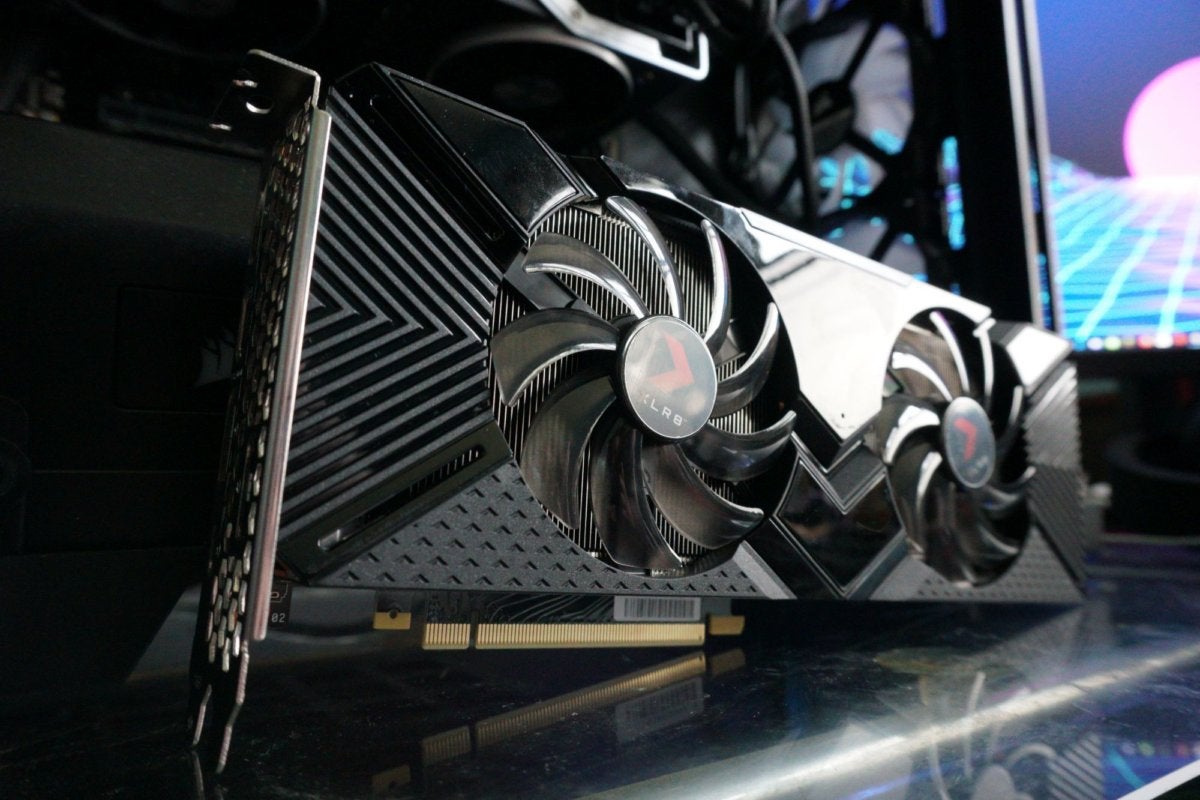 Brad Chacos/IDG
Brad Chacos/IDG Okay card, outrageous price
If you're fain to consider $850 or so for an RTX 2080 with better cooling system performance, we'd recommend saving a couple of pennies and opting for the Asus ROG Genus Strix RTX 2080 ($870 connected NeweggRemove non-product link) instead. Information technology runs deuced cold in Performance mode operating theater all but silent in Unagitated mode, and it's dead loaded with supernumerary features, including those dual BIOSes.
Should you invest in an RTX artwork card at all, though? That's a sensible question in itself. Any GeForce RTX 2080 delivers great 4K/60Hz surgery 1440p/144Hz gameplay. But so does the GTX 1080 Ti, which lacks future-facing ray-tracing and AI ironware but delivers virtually selfsame performance in traditional games for $100 to $250 less. Stay out our GeForce RTX 2080 vs. GTX 1080 Ti breakdown for all the info you need to know.
Note: When you purchase something after clicking links in our articles, we may earn a small commission. Read our affiliate connection policy for more inside information.
Source: https://www.pcworld.com/article/402662/pny-geforce-rtx-2080-xlr8-gaming-overclocked-edition-review.html
Posted by: romansquels.blogspot.com

0 Response to "PNY GeForce RTX 2080 XLR8 Gaming Overclocked Edition review: Okay but overpriced - romansquels"
Post a Comment